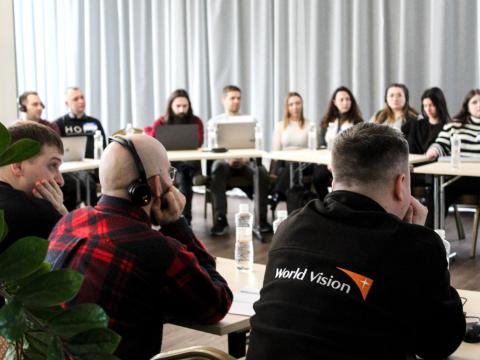Institutionalising Resilience: the World Vision Story
DownloadInstitutionalising Resilience: the World Vision Story written with the Overseas Development Institute, is now available: http://www.odi.org/publications/8616-institutionalising-resilience-development-programming
Executive Summary
It is widely recognised across the humanitarian and development community that we cannot allow people to suffer through repeated crises. World Vision has been embedding disaster risk reduction and more recently resilience into its development and humanitarian practice to safe guard livelihoods as well as lives. This paper reviews World Vision’s experience of institutionalising resilience through the use of an analytical framework around three spheres of change: programming context, organisational context and external policy and market context.Key questions around each sphere have been used to ascertain the extent to which World Vision has been able to institutionalise resilience, as opposed to undertaking discrete risk reduction programming. This research is based on: interviews with World Vision staff, review of internal strategies, best practice case studies of programming (Gaza, Ethiopia and Somalia), and a selection of partnerships for advocacy, technical advice and programming have been brought together to answer this question. From the research study, it is clear that World Vision recognises that it is important to include disaster risk reduction (DRR) and climate change adaptation (CCA) into its area development programmes as a matter of routine. There have been advances in programme design and implementation around risk awareness and preparedness measures. Recently, World Vision’s programme effectiveness guidance has included a broader understanding of resilience – tackling root causes of vulnerability and ensuring sustainability. Cross sectoral working, as well as preventing, preparing, adapting and recovering from changing risks are now included into design processes as well as annual reporting for each National Office.
The extent to which World Vision has been able to institutionalise aspects of resilience thinking – such as use of information on trends for flexible decision making – is still emerging. The Somalia Resilience Programme (SomReP) is one of the best examples of ensuring early warning systems feed into contingency plans to ensure timely interventions to secure people’s livelihoods in the face of changing risks. Additionally, whilst still in its early stages of adoption within WV, the cross sector approaches being employed throughout Africa are starting to seriously address the goal of improved and resilient livelihoods of smallholder farmers in drought prone areas through addressing the business systems of farming and market access, the management of productive natural resources and the mitigation of risk through savings, insurance, productive social safety nets and local level farmers information systems.
A set of findings have been gathered together to encourage World Vision to deepen its institutionalising of resilience as well as share recommendations with policy makers, senior management and national directors of non-governmental agencies who are also embarking on an institutionalising resilience journey.
1.1 Programming Findings: Systematising Risk Reduction through Resilient Development Practice
Overall, the extent to which WV has enhanced programme quality and effectiveness that promotes resilient development practice has been varied but key lessons on how to do so have been achieved in the lifetime of the strategy.
Enable Programme Management Systems and Sectoral Guidance to be Risk Smart
Multi hazard risk assessment and resilience approaches for all sectors should be built into programme management systems (assessment, design, monitoring and evaluation) when implementing long term development interventions so that sector projects are risk sensitive and addressing root causes of vulnerability to shocks and stresses. This helps the design process by addressing the key question of: resilience to what? And for whom? i.e. what is the nature of risk in that context and how can it be mitigated. Who has the greatest exposure to risk?
Develop theory of change to establish how resilience will be built and for whom
When designing programmes to address long term resilience, a clear theory or pathway of change is vital to ensure project interventions do not just deal with symptoms but aim towards resilience outcomes. This will also help in the targeting of “whose resilience” is being built and how they envisage progressing out of vulnerability to a more resilient state.
Combine sector programmes to address root causes of vulnerability with regular context monitoring
Integrated sector programmes build the foundations of resilient livelihoods with the aim of reducing dependency on external assistance. Determining which sectors to integrate requires a systems analysis of the drivers of vulnerability in any given context. In addition, a consistent focus on context monitoring at the local level through a real time Early Warning/Early Action system enables a more responsive and flexible approach to programming that can adapt based on predicted future risk scenarios. In WV’s recent experience this approach has already averted food shortages and potential for migration with certain groups in Somalia.
Maximise the participation of Children and Youth, including those outside formal groups
The involvement of children and youth in school and community DRR groups has significant benefits for long term resilience. The catalytic effect of both engaging and educating children and youth has been shown to influence family, community and local government practices that reduce future risk.
1.2 Organisational Findings: Adaptive and flexible organisation
World Vision’s experience suggests that creating adaptive organisational capacities and systems that can support resilient development practice requires actions across a number of areas: procedures; evidence development; capacity development. Further it suggests that a more proactive approach to resilience building is needed in the identification of risk through systematised Early Warning and Early Action and in the aftermath of a disaster.
Adapt management systems and corporate performance measures towards resilience outcomes and processes
Good resilient development practice at the local level can be reinforced and supported through appropriate management systems and metrics at National level. WV’s experience in institutionalising the “drivers of sustainability” into the National Office performance metrics and annual Child Wellbeing reporting has strengthened efforts and focus at a local level and started to build evidence for good practice.
Develop financial tracking system to measure resilience expenditure
Resilience will take root in organisations once they can establish a way of monitoring and quantifying financial allocations to initiatives that contribute to resilience outcomes. WV’s experience to date suggests that far greater emphasis is required to establish common financial metrics that can be applied across all programmes especially during a transition from community level disaster risk reduction (DRR) to a wider multi-sectoral approach to resilience building. This same challenge will need to be taken up by governments where a similar budget tracking approach is being proposed within the negotiations surrounding the Post 2015 Disaster Risk Reduction Framework.
Resource Staff Capacity through Peer to Peer Learning
Peer to peer learning and knowledge sharing through Communities of Practice (CoP) has a catalytic and positive effect on staff capacities and competencies. CoPs that actively promote interaction between field level practitioners, regional resilience coordinators and funding / policy offices can see the multiplier effect of connecting people across complex multi-layered organisations. WV’s experience with their Resilience CoP indicates that, when drawing multi-sector groups together to discuss resilience, voluntary participation is not always sufficient on its own and needs to be reinforced by incorporating participation into staff performance objectives.
Institutionalise Early Warning Early Action system at multiple levels of management
Early Warning / Early Action systems can enhance resilience and reduce the need for external humanitarian assistance when they target decision makers at multiple levels and provide them with relevant management information on potential risk scenarios and recommended early actions. WV’s experience in this regard through real time risk monitoring has led to early management decisions for preparedness and mitigation and in some cases early response before a disaster became a crisis.
Capitalise on risk awareness in the organisation and the community in aftermath of a disasters
World Vision’s experience suggests that effective integration of DRR/CCA into programming was enabled by a growing interest in resilience after a disaster. Take the opportunity to champion DRR/CCA integration into programming, organisational procedures, policy and advocacy during the aftermath of a disaster. This would involve the lessons from previous emergencies being built into relief staff orientation and the recovery strategy being built around resilient development practice outcomes for the long term.
1.3 Policy and External Market Findings: Engaging externally for greater impact
Evidence from this review shows that working in partnership externally can: enhance policy coherence at local and global levels; mobilise resources through field level consortium; develop staff capacity through knowledge sharing and strengthen industry standards for enhanced impact at a local level.
Work in partnership with evidence for effective advocacy on risk reduction
Advocacy is far more effective when carried out through coalitions and built on a strong empirical foundation. The policy influence brought to bear on the current and future HFA through WV’s work with the CCC Coalition has always been built from local level consultations with children and communities. As such far greater consistency between policy objectives and real needs on the ground can be pursued.
Mobilise resources through project based consortia
WV’s experience indicates that increased resources can be mobilised for resilient development practice when working in project based consortia. The evidence from both the ACCRA partnership in Uganda and SomRep Consortium in Somalia both demonstrate that the costs of consortia is outweighed by the multiple benefits of working together, not least in terms of resource mobilisation. Special attention however needs to be paid to the sustainability of these benefits for the long term.
Strengthen learning opportunities and staff development through multiagency partnerships
Staff capacity is frequently enhanced through peer agency learning opportunities. Working with the ECB Project with its innovative country consortia and participatory process used to develop “Toward Resilience” had a significant and positive impact on local and global level WV staff involved.
Improve quality standards through innovative partnerships
Using the collective wisdom of multiple agencies through different types of partnership promotes innovation and enhances quality. Evidence drawn from the examples of external engagement reviewed had a common thread running through them that aimed to enhance innovative practice and programme quality. For example, the ECB partnership raised the standard in terms of industry best practice guidance; the ACCRA project promoted innovation through partnership with governments and research institutions.


